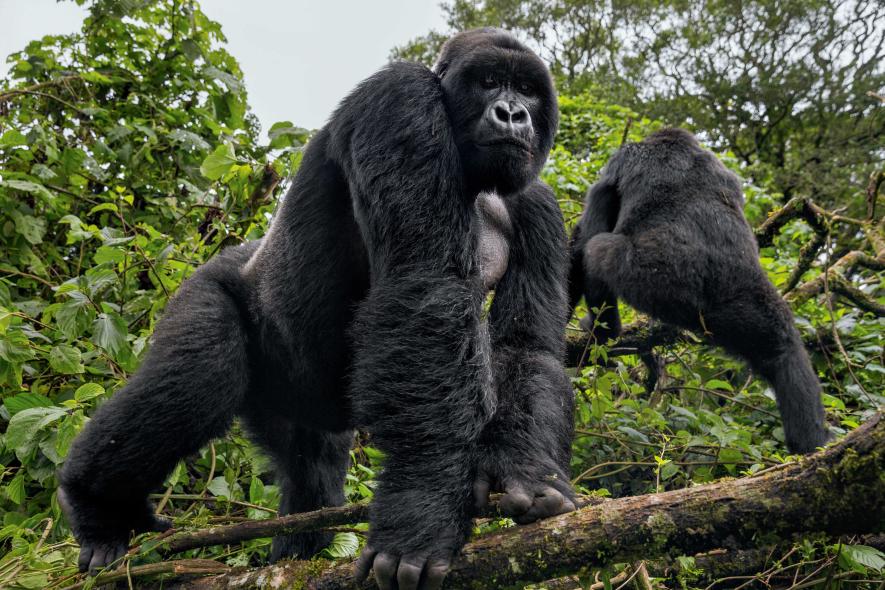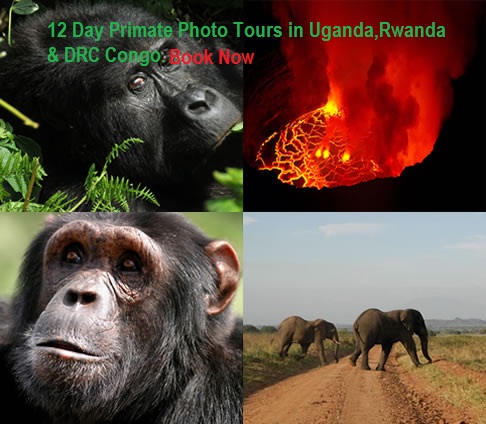As one of the ultimate wildlife experiences in Africa, gorilla trekking safaris are becoming more and more popular in Rwanda and Uganda. Luckily strict regulations are in place to protect these gentle giants, and the number of permits available per day is finite. Only eight visitors can spend one hour with a habituated gorilla group per day.
Rwanda has 12 groups available for tracking in Volcanoes National Park, and Uganda has 13 groups in Bwindi Impenetrable National Park and just one group in Mgahinga Gorilla National Park. Uganda has more habituated mountain gorillas and so admits more trekkers per day. About 80 people a day are allowed to visit Uganda’s gorillas. In Rwanda, the number of daily visitors is about 56.
The habitat and landscape of the main gorilla trekking parks in Uganda and Rwanda are very different. Rwanda’s Volcanoes National Park is part of a mostly dormant volcanic mountain range known as the Virunga’s. Here, the gorillas stay almost exclusively in the bamboo forest zone, a beautiful setting in which to see these great apes.
The vegetation tends to be quite open, which is ideal for easy viewing. Uganda’s most popular for affordable gorilla trekking safari destination, Bwindi Impenetrable National Park, is an extensive tract of tropical rain forest. It’s a stunning setting as well, but as the name suggests, the denser vegetation can sometimes make clear views of the gorillas a bit more challenging.
The price of a gorilla trekking permit in Uganda is US$700 and in Rwanda it’s US$1,500 per person. This fee doesn’t include any travel arrangements, such as transport, your guide, accommodation etc. It only covers the activity, the park ranger who will be your guide for gorilla trekking, and the trackers who go ahead to find the gorillas. Tips for the guide, trackers and optional porter are extra. The choice now remains in the hands of the traveler but if your budget is so tight then go for Uganda.
In general, the trek conditions tend to be a bit easier in Rwanda than in Uganda. This is not absolute though. Conditions change daily depending on the location of the gorillas.
Each gorilla group has its territory and some of them are usually easier to reach than others. Conditions tend to deteriorate after heavy rain when the forest paths become very slippery. This is especially true in Bwindi, which sees very high rainfall throughout the year.
The tracks in Rwanda are usually quite defined, while the tracks in Uganda tend to be very steep and overgrown. Not forgetting the high altitude in Rwanda which can also be a challenge for some people.
There are good accommodation options for gorilla trekking in Rwanda and Uganda. Rwanda has perhaps more choice in top-end luxury lodges, while Uganda has a few more mid-range options. Several lodges in Uganda border the park and have a true forest feel, while in Rwanda many lodges have mountain and/or lake views, but most are a bit farther away from the forest boundary.
Volcanoes National Park in Rwanda is considerably more accessible than Bwindi Impenetrable National Park in Uganda. The drive from Rwanda’s capital city, Kigali, to Volcanoes National Park takes up to 3 hours on a good road. The drive from Entebbe, Uganda’s gateway for most visitors, to Bwindi takes between 8 and 10 hours. While there is only one starting point for gorilla treks in Rwanda, there are four different trailheads in Bwindi. Some of them require a good 4×4 to get to. There are, however, scheduled flights to Bwindi.
Most people will incorporate a gorilla trek into a longer safari. For this, Uganda has more options than Rwanda. Uganda’s Murchison Falls and Queen Elizabeth National Parks are two top-notch Savannah reserves. You’ll see most iconic safari animals here, including elephants, lions, buffalo and giraffes.
All the Big Five are present except for rhinos, which can be seen in Ziwa Rhino Sanctuary. Uganda is also a top destination for chimpanzee trekking, while Lake Bunyonyi is a great place to chill out for a couple of days at the end of an action-packed safari.
Rwanda is less established as a stand-alone safari destination, but it has a few very good off-the-beaten-track gems worth tagging onto your gorilla trek. Most notable are Akagera National Park, a scenic Big Five Savannah park, and Nyungwe National Park, a montane rain forest, which is home to 13 primate species, including chimpanzees.
The best time for gorilla trekking in Rwanda and Uganda is from June to August and to a lesser extent from December to February. These are the driest months. At this time, the trails tend to be less slippery and hiking in the forest is easier.
Your experience will be less likely interrupted by rain. However, Volcanoes National Park in Rwanda sees less rainfall overall and conditions are mostly fine from May to February.
Bwindi is a rain forest, and you can get wet here at any time. You’ll still see the gorillas though. As long as you avoid the peaks of the rains (April to May and October to November).

